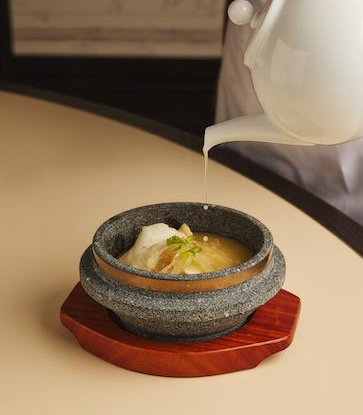Simply known as “Kachang Puteh”, the metallic pushcart is crammed with 20 types of nuts, legumes and crackers that are housed in bright red-capped bottles. Popular nibbles include cashew nuts, tapioca fritters, sugar-coated peanuts, prawn sticks and murukku. For those who prefer to pop something warm into their mouths, there are also lightly-salted boiled peanuts and chickpeas that are served warm from an electric steamer. Customers can pick and choose which munchies to fill up their folded paper cones (from $1 for two types of snacks).
Mending the stall is Amirthaalangaram Moorthy, a third-generation kachang puteh seller, who arrived here in 2004 from his native Tamil Nadu to continue his family business. The Singapore permanent resident hails from a family that has a long-standing history with kachang puteh. The 51-year-old says that many kachang puteh sellers live in his ancestral village in southern India due to the abundance of nuts grown in the area.

Moorthy says that sales at his stall is dwindling as snacks such as popcorn and potato chips are more popular these days. He laments with a shrug: “Last time, there were many kachang puteh sellers outside cinemas in areas such as Yishun and Ang Mo Kio. There were many other kachang puteh sellers outside Hoover Theatre too. Now, there is nobody.”
Why is the kachang puteh trade fading out? He says: “Usually fathers would pass their skills to their sons, but most people do not want to continue this as it is a difficult business.”

During his rest day on Sundays, Moorthy spends four hours preparing and seasoning the snacks and nuts that he buys from a wholesaler. His family works up a sweat, removing the skin from the peanuts, frying the nuts and coating them in seasonings such as satay sauce, sugar and salt.
While business has taken a dip, Moorthy says that his business “can still survive”. It receives up to 300 customers daily with middle-aged Singaporeans, who have grown up with the snack, making the bulk. Occasionally, wide-eyed tourists and millennials would whip out their phones to snap photos of this sight from a bygone era. He sells 7kg of boiled peanuts and chickpeas a week.
“" I prefer to stay on the streets, which is where kachang puteh should be" - Amirthaalangaram Moorthy”

Despite these challenges, he hopes to keep his kachang puteh stall open as long as possible. He says with a grin: “I like selling kachang puteh as I want to continue what my father started.” On whether he hopes to move into a shop someday, he shakes his head and says: “Rental is already so high. I prefer to stay on the streets, which is where kachang puteh should be.”
Some interesting picks from Moorthy’s kachang puteh stall:
1. Tepung peanuts (peanuts fried in flour)
2. Satay broad beans
3. Sweet tapioca fritters
























